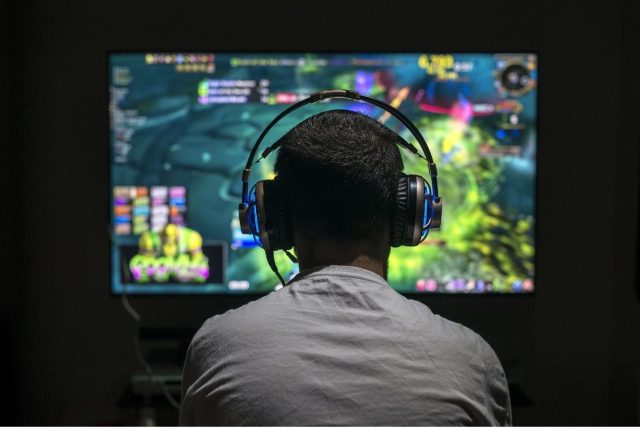In the last decade, technology has permeated every component of our lives. From mobile phones to talking refrigerators to the rise of influencers, tech has opened entirely new approaches to everything we do. The tech boom has created an entire sub-category with its own culture – gaming. You might be surprised to learn that the military has a workforce strategy that includes recruiting, developing, and utilizing gaming talent. Smoothstack graduates who are avid gamers are very appealing candidates for military openings.
The Army invests heavily in video game development. In 2002, the Army launched America’s Army and in 2008 made another commitment for $50 million to the gaming industry1. Video games such as America’s Army and Call of Duty aid in traditional recruiting practices2 by allowing potential recruits to explore the Army at their own pace. These video games are so effective for attracting recruits that the Navy dropped all their TV advertising last year in favor of digital platforms, including competitive gaming.3
Esports
The military actively participates in Esports (competitive gaming), and all four military branches/services have teams or official players. These official players socialize and explain military life to viewers while playing video games7. A popular game streaming platform, Twitch allows military players to interact directly with viewers, increasing engagement with potential recruits. Through networks like Twitch, gamers may also win prizes provided by the U.S. Military.[1] The next time you play Call of Duty, Fortnite, League of Legends, or other games, you may be playing with the military.
Readiness
Military-themed board games such as Risk and Battleship have historically been used to teach military tactics[2]. With the advent of video games, soldiers have been encouraged to play to continue combat training as these simulations provide a valuable addition to real world training. With gaming, soldiers can rehearse many scenarios that they might encounter in the real world. Gaming provides a safer approach to readiness, and it provides multiple perspectives of the battlefield that soldiers can learn from.[3]
PTSD is a growing concern in the military and Virtual Reality Exposure Therapy (VRT) is one of the most effective options for treating PTSD. [4] Programs such as Virtual Vietnam and Virtual Iraq have been built on gaming platforms to create controlled environments to gradually expose patients to stressful situations.
What’s Next
Thanks to Oculus Rift and other platforms, immersive virtual reality gaming is becoming the mainstay. The military has always been on the forefront of digital simulations for flight training and even ground combat. In the years ahead, look for them to find new ways to use gaming technology. As technology improves, gaming simulations will become more immersive. Chances are you won’t be approached by some alien planet based on your gaming skills. But if you are good enough, the U.S. military may take notice.
How the Military Uses Your Gaming Skills
In the 1984 film, The Last Starfighter, a high school student gets the high score on a video game and finds himself recruited by the Star League to fight an intergalactic war. Reality isn’t quite as exciting, but the military is very interested in your gaming skills.
Over the years, traditional recruiting approaches have not always produced the desired number of qualified recruits. All of the services have made digital investments as part of their recruiting approach. The Army has been investing in various games since about 2002. In 2008 they announced they were investing $50 million dollars in the gaming industry[5]. Call of Duty in particular, has been a very effective recruiting tool. [6] Beginning last year, the Navy dropped all their TV advertising in favor of digital platforms. [7]
Esports
Not only is the military following the gaming world, but they are also actively part of it. Since 2018, the military has Esports teams for the most popular multiplayer games. The next time you play Call of Duty, Fortnite, League of Legends, or other games, the military may be checking out your skills. Through networks like Twitch, gamers may even win prizes provided by the U.S. Military.[8] It can also be the first step in recruiting new service members. The approach is not without some controversy since some of the top players aren’t old enough to drive yet. Promoting the military to 12-year old’s is not welcome by some groups. For now, the approach seems to be working out well for both the military and the gamers who have the right stuff.
Readiness
Board games such as Risk and Battleship were used by the military for years to supplement training[9]. A lot of that went virtual once person computers came along. Either way, simulations provide a valuable addition to real world training. Even simple visualization has been used by sports teams to improve performance. With gaming, soldiers can rehearse many scenarios that they might encounter in the real world. And they can do so without even stubbing a toe. Covid provided additional incentive to use gaming for readiness. The close quarters of a tank, Humvee, or even the back of a C-130 can provide the environment to spread a virus. Gaming provides a safer approach to readiness, and it provides multiple perspectives of the battlefield that soldiers can learn from.[10]
There’s a certain irony that many of the events portrayed in violent online games can also be part of the treatment for PTSD for returning soldiers. Virtual Reality Exposure Therapy (VRT) is one of the most effective options for treating PTSD. [11] Programs such as Virtual Vietnam and Virtual Iraq have been built on gaming platforms to create controlled environments to gradually expose patients to stressful situations. The approach is not without controversy as some researchers feel that it may not help as much as it is reported to.
What’s Next
Thanks to Oculus Rift and other platforms, immersive virtual reality gaming is becoming the mainstay. The military has always been on the forefront of digital simulations for flight training and even ground combat. In the years ahead, look for them to find new ways to use gaming technology. Look for things to get more realistic as technology improves. Chances are you won’t be approached by some alien planet based on your gaming skills. But if you are good enough, the U.S. military may take notice.
[1] https://www.vox.com/2020/8/14/21367819/video-games-twitch-military-recruitment-america-army-navy-reset-podcast
[2] https://theconversation.com/how-the-us-military-is-using-violent-chaotic-beautiful-video-games-to-train-soldiers-73826
[3] https://www.army.mil/article/235085/soldiers_maintain_readiness_playing_video_games
[4] https://kuscholarworks.ku.edu/bitstream/handle/1808/25311/Derby_2016.pdf?sequence=1&isAllowed=y
[5] https://arstechnica.com/gaming/2019/01/army-video-games/
[6] https://gamerant.com/call-duty-modern-warfare-recruitment-tool/
[7] https://www.npr.org/2020/08/13/902073826/the-u-s-military-is-using-esports-as-a-recruitment-tool
[8] https://www.vox.com/2020/8/14/21367819/video-games-twitch-military-recruitment-america-army-navy-reset-podcast
[9] https://theconversation.com/how-the-us-military-is-using-violent-chaotic-beautiful-video-games-to-train-soldiers-73826
[10] https://www.army.mil/article/235085/soldiers_maintain_readiness_playing_video_games
[11] https://kuscholarworks.ku.edu/bitstream/handle/1808/25311/Derby_2016.pdf?sequence=1&isAllowed=y








